Iconic architecture design, Starchitects, Celebrity designers theory, Famous buildings opinion
Iconic Buildings Design : Architecture Debate
Discussion on Current Architectural Topics – Built Environment Critique.
15 Oct 2005
Article by Charles Blanc, Glasgow, for e-architect
Iconic Architecture – Good Architecture?
Iconic Architecture
Yesterday I read with interest Adrian Welch’s text on iconic architecture design, signatecture, which brought up interesting ways of opening up the discussion instead of dwarfing it into one mindset or the other. I especially valued the idea of developing post occupation studies of buildings to assess their definition as “good” architecture.
But the definition of the street as a gallery of buildings made me cringe a little [Ed – fair comment, not my phrase, from Charles Knevitt’s Channel 4 book back in the Eighties, though the point was really to get across how public the ‘art of architecture’ is]. The street is indeed lined by buildings, but what defines it is the empty space created, not the buildings per se. When Barcelona started its regeneration in the 80’s, it was realised by reconsidering and enhancing these empty spaces, not by changing the gallery surrounding them. It came with a few new builds, but around these new public spaces so envied by other European cities, there are only “ordinary” buildings. The energy was spent on the actual place rather than the image.
Guggenheim Museum Bilbao design by architect Frank Gehry
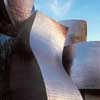
photo © Guggenheim Museum Bilbao
The suggestion that architects should improve their lot by engaging in everyday aspects of people’s lives is a bit daunting. Taken to the extreme, it reminded me of Loos’ short text, The poor rich man, where an architect not only designs a house for his client but goes as far as designing every detail of the Rich Man’s home; he anticipated everything, even the pattern on his slippers. One day, the Poor Rich Man’s family offered him birthday presents, but the architect, summoned to find correct places for them in his composition, was furious that a client had dared to accept presents about which he, the architect, had not been consulted.
For the house was altogether finished, as was his client: he was complete. This holistic design of an environment might be some architects dream, but it usually becomes other people’s nightmares. Accidents and incidents are essential for real life. Architects design spaces for people to live in, not only for magazine to take pictures of and for developers to market them. The debate is a bit more interesting, I hope. Cities tend to become attraction parks for architects to “perform” and developers to show their protégé. The strength of an architect is to do “good” buildings using and playing with the existing context rather than try to create a stand-alone object to look at within an ideal sterilised site.
One side of the argument for iconic objects, well side-tracked by Adrian Welch, is to defend the populism of such attitudes: the architect’s job is to “service society’s need for instant gratification”. Architecture is not a sausage roll. That is mere construction and bad product design. This forum is not the place for it, but I can’t resist responding to this attitude. There is such an unpleasant condescendence in separating the people and ourselves, and giving them something that we wouldn’t consider good enough for us. Disneyland, or Celebration to make it more architectural, might be successful, but quality has never been defined by numbers. Our role is to provide a creative answer to a brief and a site, going further than a hollow image, what ever the brief is.
Sydney Opera House by Jørn Utzon
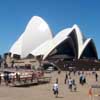
photo © Derek McGavigan, 2010
It doesn’t mean that we should replace the “ordinary” architecture Adrian Welch is talking about. Please don’t touch the ordinary buildings, don’t confound modesty and mediocrity. Ordinary buildings are honest and without pretensions, a simple shed can be far more interesting architecturally than a shed trying to be a town hall or a Greek temple. There can be a real beauty and intelligence in the simplicity of the volumes and materials, often involuntary, but we shouldn’t dismiss it. I remember an insignificant small garage/substation in Glasgow at the corner of Cathedral street and North Hanover street, with interesting proportions and clever details.
Six months after the redevelopment of the Buchanan Shopping centre, it was done up and is now a horrible little thing, looking like a suburban house gone wrong. Before, it existed and was pleasing in its simplicity, now I always have to turn my head. I am not criticising the status of the brief, but the result in trying to transform an ordinary building into “recognisable” architecture. If the occasion arises, the ordinary brief of a shed or factory is as interesting (look at factory designs from Alvar Aalto, Herzog & de Meuron or Jacques Ferrier) as more mediatised ones and should be considered and discussed on the same level in architectural debates. I would agree with Gordon Murray that the peripheries of our cities and their unfashionable briefs have to be considered by architects and are essential to a positive development of our cities. But please don’t touch the ordinary buildings.
Iconic Architecture – article by Charles Blanc
15 Oct 2005
Architectural texts are welcome – no limit to words
Iconic Buildings
Swiss Re, London, England, UK
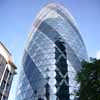
photograph © Adrian Welch
Singapore Tower, Singapore
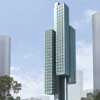
image from architects
Russia Tower, Russia
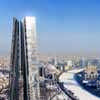
image : Foster + Partners
Older Iconic Architecture
Reichstag, Berlin, Germany
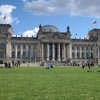
photo © Adrian Welch
Guggenheim New York, New York City, NY, USA
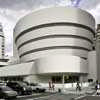
photo : David M. Heald, © SRGF, New York
Icon Buildings : list of most celebrated building designs from across the globe
Comments for the Iconic Architecture – Icon Buildings page welcome.
